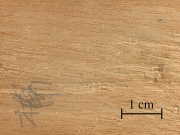Difference between revisions of "Red machilus"
Jump to navigation
Jump to search
| Line 2: | Line 2: | ||
== Description == | == Description == | ||
| − | A large, sturdy evergreen tree (''Machilus thunbergii'') native to temperate and subtropical forests of Japan and Asia. The Japanese bay tree can reach 10–30 m (30–100 ft) tall, and 20 m (70 ft) width. It is used for timber and as a street tree. Its bark is the source of makko, a powder used to make a mosquito‑repelling incense. | + | A large, sturdy evergreen tree (''Machilus thunbergii'') native to temperate and subtropical forests of Japan and Asia. The Japanese bay tree can reach 10–30 m (30–100 ft) tall, and 20 m (70 ft) width. It is used for timber and as a street tree. Its bark is the source of makko, a powder used to make a mosquito‑repelling incense. The wood is used in making instruments and furniture. |
== Synonyms and Related Terms == | == Synonyms and Related Terms == | ||
| Line 13: | Line 13: | ||
* Bark = rough, brownish-grey, breaks off in aromatic chunks | * Bark = rough, brownish-grey, breaks off in aromatic chunks | ||
* Flowers = clusters of small bright green stars in spring followed by blue berries in early summer | * Flowers = clusters of small bright green stars in spring followed by blue berries in early summer | ||
| + | * Heartwood is reddish brown | ||
==Resources and Citations== | ==Resources and Citations== | ||
Latest revision as of 13:11, 19 September 2022
Description
A large, sturdy evergreen tree (Machilus thunbergii) native to temperate and subtropical forests of Japan and Asia. The Japanese bay tree can reach 10–30 m (30–100 ft) tall, and 20 m (70 ft) width. It is used for timber and as a street tree. Its bark is the source of makko, a powder used to make a mosquito‑repelling incense. The wood is used in making instruments and furniture.
Synonyms and Related Terms
Machilus thunbergii; Japanese bay tree; tabunoki;
Physical and Chemical Properties
- Leaves = dark green shiny, 8-15 cm long, 3-7 cm wide.
- Leaves contain sap
- Bark = rough, brownish-grey, breaks off in aromatic chunks
- Flowers = clusters of small bright green stars in spring followed by blue berries in early summer
- Heartwood is reddish brown
Resources and Citations
- Wikipedia: Machilus thunbergii Accessed 9/19/22.
- Botany Boy: Japans huge bay tree
